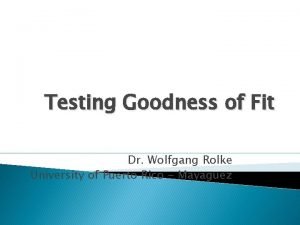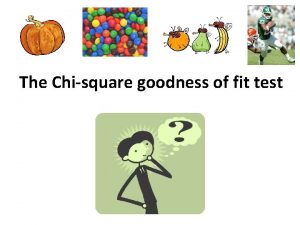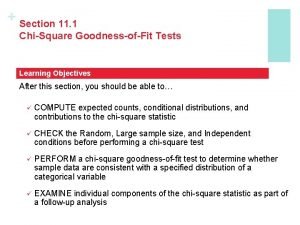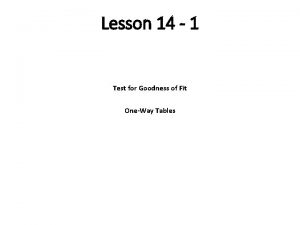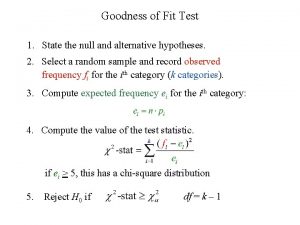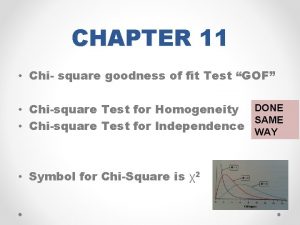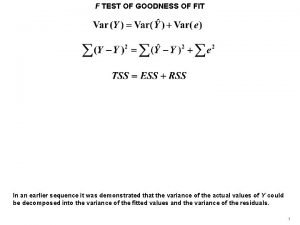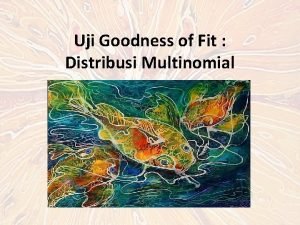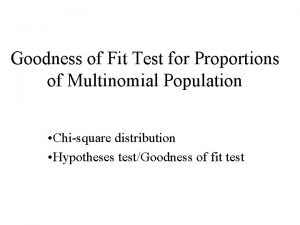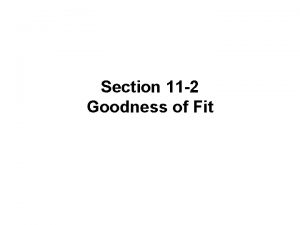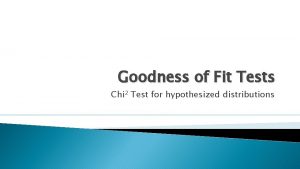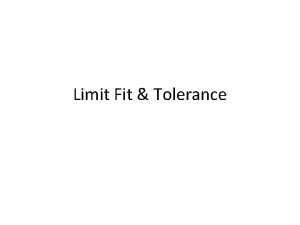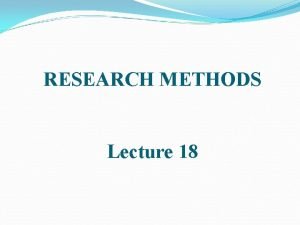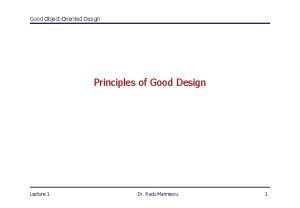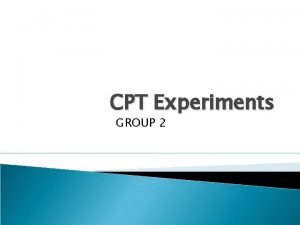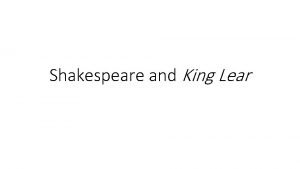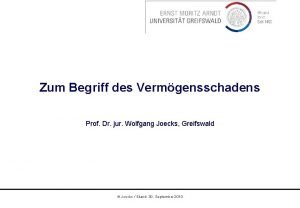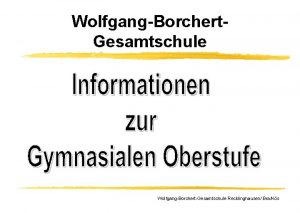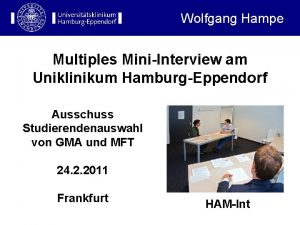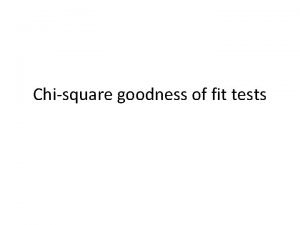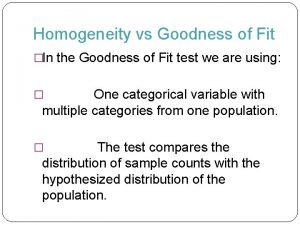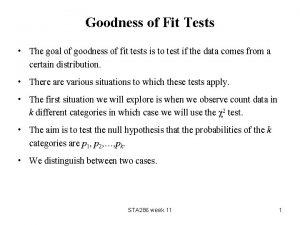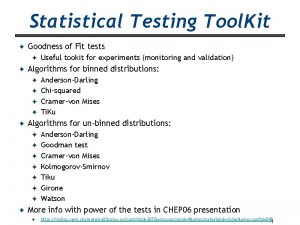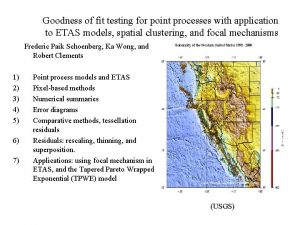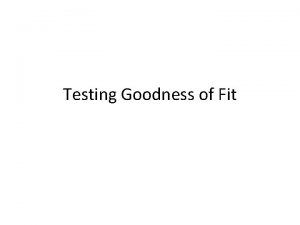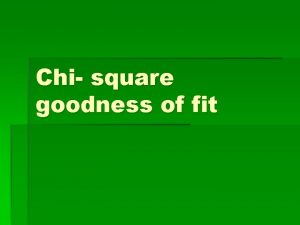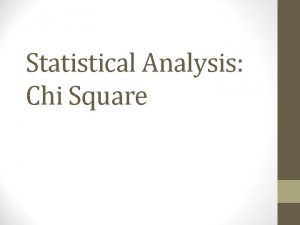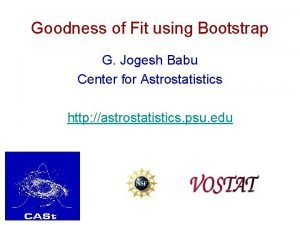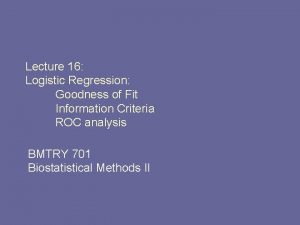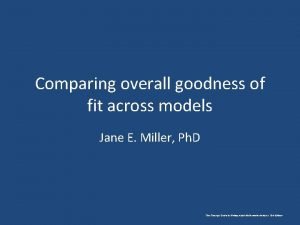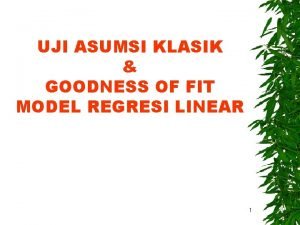Testing Goodness of Fit Dr Wolfgang Rolke University























































- Slides: 55

Testing Goodness of Fit Dr. Wolfgang Rolke University of Puerto Rico - Mayaguez

Table of Content �


The Archetypical Statistics Problem: Ø There is a theory Ø There is data from an experiment Ø Does the data agree with theory?

Example: Is the die fair? � 1 2 3 4 5 6 187 168 161 147 176 161

Sir Karl Pearson 1900, “On the criterion that a given system of deviations from the probable in the case of correlated system of variables is such that it can be reasonably supposed to have arisen from random sampling”, Phil. Mag (5) 50, 157 -175


1 2 3 4 5 6 O 187 168 161 147 176 161 E 167 167 167 �

Pearson’s Reasoning



Hypothesis Testing Basics � Type I error: reject true null hypothesis � Type II error: fail to reject false null hypothesis 1: A HT has to have a true type I error probability no higher than the nominal one 2: The probability of committing the type II error should be as low as possible (subject to 1) Historically 1 was achieved either by finding an exact test or having a large enough sample.

Neyman, Jerzy; Pearson, Egon S. (1933). "On the Problem of the Most Efficient Tests of Statistical Hypotheses". Philosophical Transactions of the Royal Society A: Mathematical, Physical and Engineering Sciences. 231 (694– 706): In a test of a simple vs simple hypotheses likelihood ratio test is most powerful




And that’s not all: �

The Degree of Freedom Controversy �


Mendel-Fisher Controversy Mendel, J. G. (1866). "Versuche über Pflanzenhybriden", Verhandlungen des naturforschenden Vereines in Brünn, Bd. IV für das Jahr, 1865, Abhandlungen: 3– 47 Discovery of Mendelian inheritance Immediate impact on Science: ZERO! Darwin could have used this when he wrote On The Origin of Species. His cousin Francis Galton (inventor of regression!) could have told him.



More than 50 papers published since 1936 have tried to figure out what happened. For a long time: it was the Gardener! Another explanation, which seems to have gained momentum in recent years: It was early in the history of experimentation, modern ideas of how to avoid (even unconscious) biases were not yet developed. Allan Franklin, A. W. F. Edwards, Daniel J. Fairbanks, Daniel L. Hartl and Teddy Seidenfeld. “Ending the Mendel-Fisher Controversy”, University of Pittsburgh Press, 2008.


Monte Carlo Simulation function(B=1 e 4) { O<-c(187, 168, 161, 147, 176, 161) E<-rep(1, 6)/6*1000 TS. Data<-rep(0, 5) TS. Data[1]<-sum( (O-E)^2/E) TS. Data[2]<-2*sum(O*log(O/E)) TS. Data[3]<-4*sum( (sqrt(O)-sqrt(E))^2) TS. Data[4]<-sum( (O-E)^2/O) TS. Data[5]<-2*sum(E*log(E/O)) TS. Sim<-matrix(0, B, 5) for(i in 1: B) { O<-table(sample(1: 6, size=1000, replace=T)) TS. Sim[i, 1]<-sum( (O-E)^2/E) TS. Sim[i, 2]<-2*sum(O*log(O/E)) TS. Sim[i, 3]<-4*sum( (sqrt(O)-sqrt(E))^2) TS. Sim[i, 4]<-sum( (O-E)^2/O) TS. Sim[i, 5]<-2*sum(E*log(E/O)) } list(TS. Data, apply(TS. Sim, 2, quantile, 0. 95)) }

Question today: Which Method has highest Power? function(B=1 e 4) { crit 95<-c(10. 95, 10. 97, 10. 95, 11. 08, 11. 00) E<-rep(1, 6)/6*1000 TS. Sim<-matrix(0, B, 5) for(i in 1: B) { O<table(sample(1: 6, size=1000, replace=T, prob=c(1. 25, 1, 1, 1))) TS. Sim[i, 1]<-sum( (O-E)^2/E) TS. Sim[i, 2]<-2*sum(O*log(O/E)) TS. Sim[i, 3]<-4*sum( (sqrt(O)-sqrt(E))^2) TS. Sim[i, 4]<-sum( (O-E)^2/O) TS. Sim[i, 5]<-2*sum(E*log(E/O)) } power<-rep(0, 5) for(i in 1: 5) power[i]<s sum(TS. Sim[, i]>crit 95[i])/B power }

George Box: All models are wrong, but some are useful Probability models are theoretical constructs, one can not expect them to be perfect fits in real life (“there is no perfect circle in nature”) → how close an agreement between null and data is needed depends on context → related to choice of type I error probability ɑ, 5%? 1%?

Overfitting Usual question: is our theory a good enough model for the data? We also should worry about: is our model better than it should be? Ø Overfitting!


Continuous Data Need to bin the data In principle any binning is ok Two Questions: 1) 2) What kind of bins? How many bins?

What kind of bins? Equi-distant – Equi-probable

Most studies suggest equi-probable is better One advantage: E=1/k >> 5 for all bins, no need to adjust binning Major advantage: In general leads to tests with higher power Bins can be found easily as quantiles of F or as quantiles of data

How many bins? �

EDF Methods �

Theorem: (Probability Integral Transform) Let X be a continuous random variable with distribution function F, then the random variable Y = F(X) has a uniform (0, 1) distribution. Consequence: D is distribution free, aka does not depend on F. One table to rule them all! Except this does not work if parameters are estimated from data!

Kolmogorov-Smirnov �

Alternatives �


R package KScorrect Uses maximum likelihood to estimate parameters and Monte Carlo simulation to estimate null distribution Example: > x<-rexp(1000, 1) > Lc. KS(x, "pexp")$p. value [1] 0. 3998




Probability Plots Plot quantiles of F vs sample quantiles If F is correct model, points form a straight line

Turn this into a formal test �

Sivan Aldor-Noima, Lawrence D. Brown, Andreas Buja , Robert A. Stine and Wolfgang Rolke, “The Power to See: A New Graphical Test of Normality”, The American Statistician (2013), Vol 67/4 Andreas Buja, Wolfgang Rolke “Calibration for Simultaneity: (Re) Sampling Methods for Simultaneous Inference with Applications to Function Estimation and Functional Data”, Technical Report, Wharton School of Business, Univ. of Pennsylvania R routines: http: //academic. uprm. edu/wrol ke/research/publications. htm

Smooth Tests �



testing composite hypotheses is possible Quite unusual: best method for estimating parameters: Mo. M (method of moments) Example:

And many more… � Tests based on moments � Tests specific for a distribution (Normal: more than 20 tests) �A good place to start: “Comparing Distributions”, Olivier Thais, Springer

Multidimensional Data �


� d=1 99. 7% d=5 89. 1% d=10 46. 8% d=20 1. 7%

GOF tests beyond 2 or 3 dimensions unlikely to be very useful. At the very least will require gigantic data sets Still a wide open problem!

Thanks!
 Next fit memory allocation
Next fit memory allocation First fit allocation
First fit allocation Wolfgang rolke
Wolfgang rolke Chi square test goodness of fit
Chi square test goodness of fit Casinos are required to verify that their games
Casinos are required to verify that their games Chi square goodness of fit p value
Chi square goodness of fit p value Goodness of fit test
Goodness of fit test How to find expected value in goodness of fit test
How to find expected value in goodness of fit test F-test formula
F-test formula Macam macam uji goodness of fit
Macam macam uji goodness of fit Multinomial goodness of fit
Multinomial goodness of fit Goodness of fit adalah
Goodness of fit adalah Goodness of fit test ti 83
Goodness of fit test ti 83 Goodness of fit
Goodness of fit Clearance fit tolerance
Clearance fit tolerance Person-job fit and person-organization fit
Person-job fit and person-organization fit 1910 134
1910 134 Framework for integrated test
Framework for integrated test But tell of days in goodness spent
But tell of days in goodness spent Good measurement
Good measurement Skala stapel
Skala stapel Good interface design
Good interface design 2 nephi 9:21
2 nephi 9:21 Experiments in goodness
Experiments in goodness Quotes of john proctor being honest
Quotes of john proctor being honest Sing of the lords goodness
Sing of the lords goodness Mercy and goodness give me assurance
Mercy and goodness give me assurance There's nothing worth
There's nothing worth I heard myself proclaimed
I heard myself proclaimed How goodness pays
How goodness pays Domain testing
Domain testing Motivational overview of logic based testing
Motivational overview of logic based testing Du path testing
Du path testing Positive and negative testing
Positive and negative testing Cs3250
Cs3250 Localization globalization testing
Localization globalization testing Neighborhood integration testing
Neighborhood integration testing Language testing
Language testing Control structure testing in software engineering
Control structure testing in software engineering Decision table testing in software testing
Decision table testing in software testing Decision table testing examples
Decision table testing examples Blackbox testing
Blackbox testing Black-box testing disebut juga sebagai behavioral testing
Black-box testing disebut juga sebagai behavioral testing Decision table for next date problem
Decision table for next date problem Rigorous testing in software testing
Rigorous testing in software testing Testing blindness in software testing
Testing blindness in software testing Component testing is a black box testing
Component testing is a black box testing Software domain examples
Software domain examples Wolfgang joecks
Wolfgang joecks Wolfgang borchert gesamtschule recklinghausen
Wolfgang borchert gesamtschule recklinghausen New wave design movement
New wave design movement Wolfgang hampe
Wolfgang hampe Wolfgang fabisch
Wolfgang fabisch He was born in salzburg austria on january 27 1756
He was born in salzburg austria on january 27 1756 Wolfgang amadeus mozart horn concerto no. 4
Wolfgang amadeus mozart horn concerto no. 4 Wolfgang amadeus mozart (1756-1791)
Wolfgang amadeus mozart (1756-1791)


